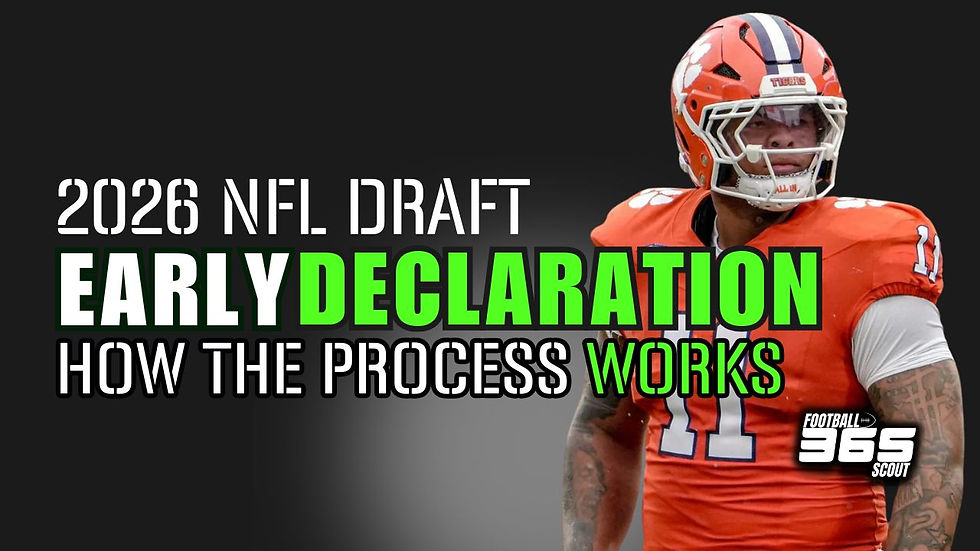Rebuilding The Chicago Bears: Is Jim Harbaugh The Answer in Chicago? Should they retain Justin Fields or draft a quarterback?
- Brandon Lundberg

- Dec 21, 2023
- 4 min read
The Chicago Bears' performance analysis for the 2023 season and strategic outlook for 2024 reveals a team in transition with potential for significant growth. On offense, the Bears showed modest improvement, increasing their points per game from 19.2 in 2022 to 20.8 in 2023 and their yards per game from 307.8 to 324.2. This upward trend, though slight, indicates an offense finding its rhythm. Defensively, the Bears made notable strides, reducing opponent points per game from 27.2 to 23.8, and slashing yards allowed dramatically from 375.9 to 314.5, signaling a robust defensive turnaround.
Heading into the 2024 season, the Bears are well-positioned financially, boasting a healthy cap space of $64.8 million. With effective cap space at $40.8 million and minimal dead money, they have ample opportunity to make strategic moves. With only 37 players currently under contract, the Bears must prioritize filling crucial positions through free agency and the draft, balancing the need for immediate impact players with long-term financial sustainability. Key potential free agents include impact players like Yannick Ngakoue and Justin Jones, alongside others who could bolster both offense and defense.
Chicago Bears Free Agent and Salary Cap Analysis for 2024 Season
Salary Cap Overview:
Cap Space: The Bears have a robust $64,785,906 in cap space, providing significant leeway for roster adjustments and strategic acquisitions.
Effective Cap Space: At $40,832,783, this figure shows the Bears' financial capacity after accounting for a minimum of 51 players, including the projected rookie class, highlighting ample room for additional signings.
Active Cap Spending: Currently, $181,385,752 is allocated towards active roster salaries.
Dead Money: A minimal amount of $859,071 in dead money showcases efficient cap management, freeing up more resources for active roster spending.
Roster Size: With 37 players under contract for 2024, below the full roster size of 51, the Bears have multiple spots to fill, opening up opportunities in free agency and the draft.
Strategic Salary Cap Considerations:
Prioritize filling crucial positional needs, particularly where the draft may lack depth.
Actively engage in free agency to complement the draft strategy, given several roster spots to fill.
Utilize the low dead money for additional financial flexibility, possibly through contract restructuring.
Balance high-value signings with maintaining cap space for future seasons.
Key Potential Free Agents:
Yannick Ngakoue (EDGE): UFA with a significant snap count of 73.7%, aged 29. Current APY: $10,500,000. A pivotal defensive player essential for maintaining a strong pass rush.
Justin Jones (IDL): UFA with 63.0% snaps, aged 28. Current APY: $6,000,000. Key to the interior defense, making him a valuable asset for the Bears' defensive line.
Lucas Patrick (LG): UFA with an 83.5% snap count, aged 31. Current APY: $4,000,000. Critical for the offensive line, especially in protecting the QB and supporting the running game.
Cairo Santos (K): Void contract, contributing 34.8% snaps, aged 33. Current APY: $3,000,000. A crucial player in special teams whose performance can influence crucial game outcomes.
Robert Tonyan (TE): UFA with 24.1% snaps, aged 30. Current APY: $2,650,000. Role as TE could be pivotal depending on his performance in the passing game.
Jaylon Johnson (CB): UFA with 78.6% snaps, aged 25. Current APY: $1,617,194. A young cornerback vital for maintaining secondary stability.
Darnell Mooney (WR): UFA with 72.6% snaps, aged 27. Current APY: $894,262. Significant to the Bears' receiving corps, potentially a key re-signing for the offense.
Potential Offseason Team Positional Needs and Analysis:
The Bears' substantial cap space positions them favorably to address key needs identified for the 2024 season. These needs include vital positions such as QB, WR, OT, EDGE, and DL. The financial flexibility combined with strategic signings and draft picks will be crucial in shaping a competitive roster for the upcoming season.
PFF Player Grade Overview
Jaylon Johnson (CB) - PFF Grade: 90.6 (2024 Free Agent)
DJ Moore (WR) - PFF Grade: 87.8
Noah Sewell (LB) - PFF Grade: 86.5
T.J. Edwards (LB) - PFF Grade: 79.5
D'Onta Foreman (HB) - PFF Grade: 76.9 (2024 Free Agent)
Montez Sweat (ED) - PFF Grade: 75.5
Justin Fields (QB) - PFF Grade: 75.1
Teven Jenkins (G) - PFF Grade: 74.4
Marcedes Lewis (TE) - PFF Grade: 73.5 (2024 Free Agent)
Khalil Herbert (HB) - PFF Grade: 77.2
Summary Analysis And Recommendations To Help Improve The Team
As indicated by the PFF data and statistics, the Chicago Bears' performance in the 2023 season highlights several areas needing improvement for greater competitiveness in the NFC North and the NFL.
Defensive Challenges (Ranked 30th): The defense is a significant concern, ranked 30th in the league. This low ranking and the high number of points allowed (309, tied for 24th) suggest critical weaknesses in stopping opposing offenses. Addressing this will require a focus on acquiring impact players in the defensive line and secondary, either through the draft or free agency. Evaluating and potentially adjusting defensive schemes could also be beneficial.
Offensive Improvements (Ranked 20th): While performing better than the defense, the offense still has room for improvement. Enhancing the offensive line to protect the quarterback better and create effective running lanes should be a priority. Enhancing the receiver group could also help increase the team's points scored.
Special Teams (Ranked 17th): This mid-tier ranking suggests a balanced performance with room for improvement. Upgrading specialist positions and improving coverage units can contribute to better field position and impact the outcome of games.
Overall Team Strategy: The Bears should focus on drafting defensive players, particularly in positions like EDGE, LB, or CB. Using available cap space judiciously in free agency to fill roster gaps, especially on defense, is crucial. Investing in developing young players, particularly in underperforming positions, is also essential.
Coaching and Schemes: The coaching staff needs to reassess their strategies on both offense and defense, maximizing the talents of the current roster and making necessary adjustments to improve overall team performance.




